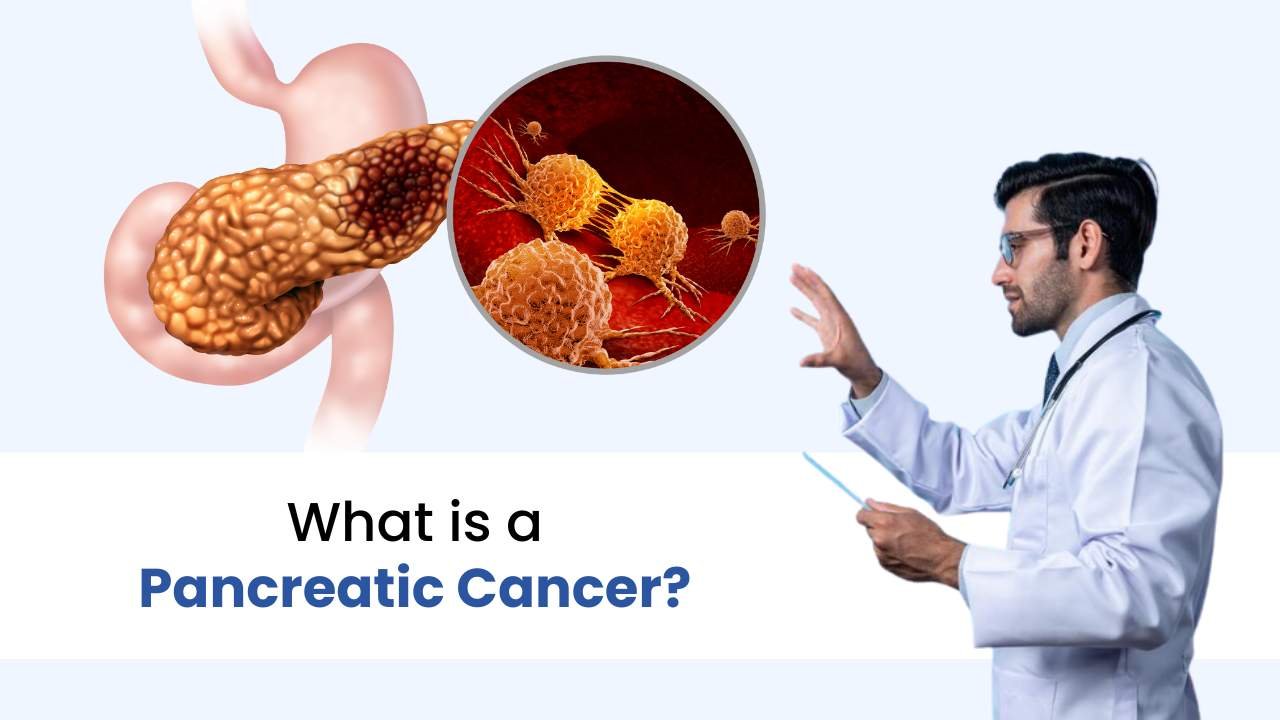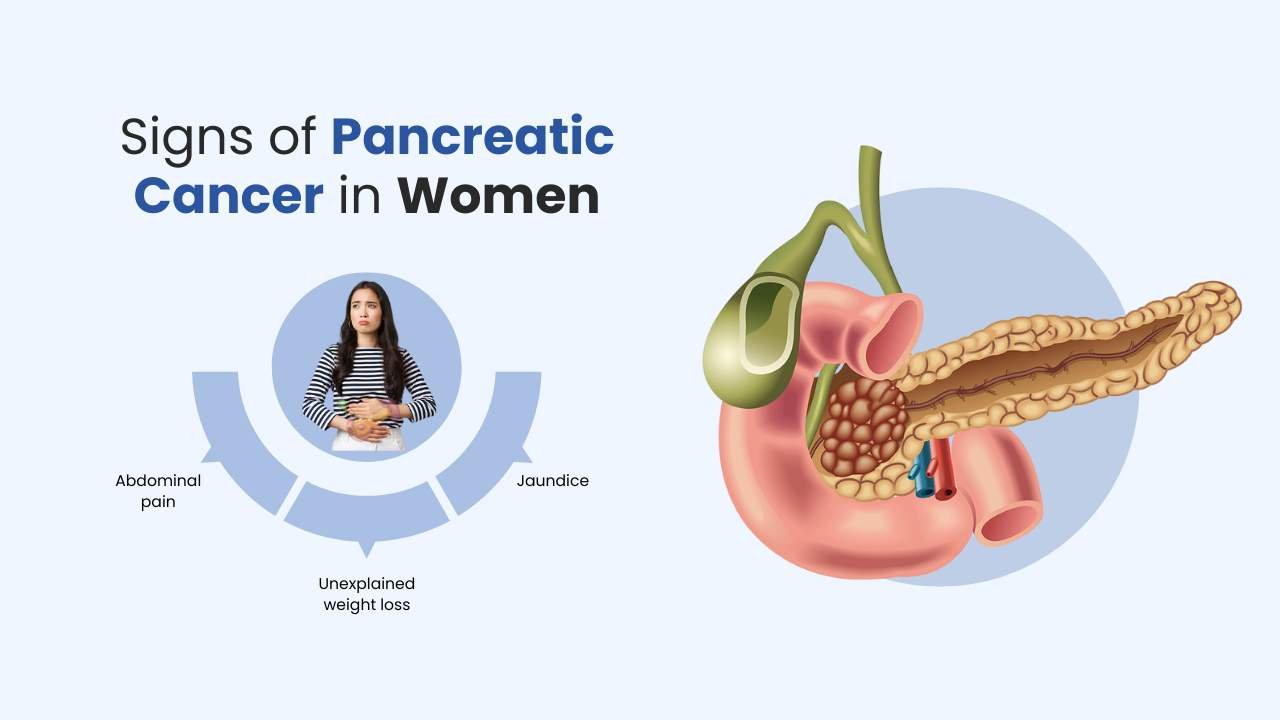Home Blogs Surgical Oncology Pancreatic Cancer Symptoms in Women: Top 10 Signs

Are you unsure about the signs of pancreatic cancer?
Do you suspect that you might have it and want to know for sure?
Don't worry, you’re in the right place to find out more.
Pancreatic cancer develops when a gland located under your stomach, known as the pancreas, starts growing out of control and forms a lump. These cells of cancer cells can also move to other parts of the body.
Read this article and get all the information about the signs of pancreatic cancer, risk factors, management, and so on.

The pancreas is located behind the stomach's lower portion. It produces hormones that aid in blood sugar regulation and digestive enzymes. However, uncontrolled multiplication of cells causes cancer. Additionally, adenocarcinoma of the pancreatic ducts is the most prevalent kind of pancreatic cancer, which starts in the cells lining the ducts that the pancreas uses to release digestive enzymes.
Moreover, it is unusual to detect pancreatic cancer in its early stages, when there is the best chance of recovery. This is because it frequently doesn't show symptoms until it has migrated to other organs.
The following are risk factors for pancreatic cancer in women:

• Abdominal pain
• Unexplained weight loss
• Loss of appetite
A sudden or persistent decrease in appetite.
• Jaundice
Yellowing of the skin, mucous membranes, or eyes is known as jaundice. Bilirubin, a byproduct of aged red blood cells, is what gives the color its yellow hue. A number of medical conditions can manifest as jaundice.
Jaundice may develop gradually or spontaneously. Common signs and symptoms of jaundice include:
• Nausea and vomiting
A tumor pressing on the stomach may cause this.
It is the feeling of darkness in front of the eyes or wanting to puke.
• Fatigue
Persistent tiredness not relieved by rest.
• Changes in stool
Greasy, light-colored stools are due to poor digestion of fat.
• New-onset diabetes or worsening diabetes
Especially in older adults without risk factors.
• Back pain
It can be a dull ache in the mid to upper back.
A few additional and specific signs can be seen only in women :

Radiation therapy, chemotherapy, endoscopic procedures, surgery, or a mix of these may be used to treat pancreatic cancer.
The Whipple procedure, which involves the removal of a portion of the pancreas, the first part of the small bowel, a portion of the stomach and gallbladder, and a portion of the bile duct, is typically the most common treatment for early illness.
In cases of advanced pancreatic cancer, surgery might not be considered. The goal of treatment is frequently to alleviate symptoms, including pain and stomach issues.
Surgical treatment for pancreatic head cancer: The Whipple procedure involves removing the pancreatic head. It also includes the removal of the first segment of the small intestine. Surgeons occasionally remove a portion of the stomach along with the lymph nodes that surround it.
Pancreatic and body cancer are surgical treatments for pancreatic head cancer. It also includes the removal of the first segment of the small intestine. Surgeons occasionally remove a portion of the stomach along with the lymph nodes that surround it.
Pancreatic and body cancer are surgically treated: An operation known as a distal pancreatectomy involves removing the pancreatic body and tail. It may also be necessary for the surgeon to remove the spleen during this treatment.
The entire pancreas is removed during surgery. We refer to this as a complete pancreatectomy. You will take medication for the rest of your life after surgery to replace the hormones and enzymes that the pancreas produces.
Surgery to treat malignancies that impact the blood vessels in the area: A more involved surgery may be required if a pancreatic cancer spreads to neighbouring blood vessels. Parts of the blood vessels may need to be removed and rebuilt during the treatment.
When surgery is not an option for the initial treatment, chemotherapy may be performed. Additionally, chemotherapy may be administered along with radiation therapy. Surgery may become feasible if the cancer is sufficiently reduced by this combination of therapies. This therapy method is provided at specialty hospitals that have treated numerous patients with pancreatic cancer.
After surgery, chemotherapy is frequently used to remove any remaining cancer cells.
Chemotherapy can assist in controlling advanced cancer that has spread to other body parts. Chemotherapy may be able to alleviate symptoms like discomfort.
It is possible to get radiation before or after surgery. It's frequently carried out after surgery. Chemotherapy can potentially be used with radiation.
Radiation therapy and chemotherapy may be used as the initial treatment when surgery is not a possibility. Surgery may become feasible with this combination of therapy, as the cancer may shrink.
Symptoms like discomfort can be alleviated by radiation therapy when the cancer spreads to other areas of the body.
Immunotherapy is a medication used to assist the body's immune system in destroying cancerous cells. The immune system targets bacteria and other cells that shouldn't be in the body to fight against illnesses. To survive, cancer cells conceal themselves from the immune system. Immunotherapy aids the cells of the immune system in locating and eliminating cancer cells. If certain genetic alterations in your pancreatic cancer increase the likelihood that the cancer may respond to immunotherapy, it may be a viable therapeutic choice.
Palliative care is implemented by a group of medical specialists. Nurses, doctors, and other professionals with specialized training may be on the team. The team wants to make your life and your family's quality of life better.
Experts in palliative care collaborate with you and your family to improve your quality of life. Radiation therapy, chemotherapy, and surgery are examples of aggressive cancer treatments that can coexist with palliative care.
Cancer patients may feel better and live longer when palliative care is combined with all other suitable treatments.
Although cancer treatment has advanced, the prognosis for pancreatic adenocarcinoma is still poor. The 5-year survival rate is around 20 percent.
90% of patients die within a year of diagnosis, despite surgery, making the prognosis bleak. Palliative surgery may be helpful, though.
Talking with the patient about treatment is crucial for those with stage IV pancreatic cancer. Chemotherapy can be administered. The toxicity and effects of the treatment are affected, but the life extension will only last for months at most. Given its impact on wound healing, diet should always be the primary focus of a patient's care.
FAQs
Early symptoms aren’t there, but if present, commonly include abdominal pain, back pain, jaundice, and weight loss.
‣ Pain
‣ Nausea, vomiting
‣ Feeling too hot or cold
‣ Eating and drinking problems
‣ Breathlessness
‣ Noisy breathing
‣ Anxiety and agitation
For pancreatic cancer, the overall five-year survival rate, or the proportion of patients still alive five years after diagnosis, is 12%. This is because many more people receive a stage IV diagnosis after the disease has spread.
As long as it is diagnosed in the early stages, the survival rate is good; hence, if you suffer from any early signs, you should visit a doctor.
At later stages, it becomes worrisome as the survival rate reduces.
Early symptoms aren’t there, but if present, commonly include abdominal pain, back pain, jaundice, and weight loss.

Written By
A hard working, patient centred, skillful and knowledgeable doctor who is always ready to learn.
From a very young age she aspired to be in the medical field, to help cure the ailing. She believes that relief on the patient's face, the smile of gratitude and the feeling of helping someone is all what matters.
SOURCE
HISTORY
At Mejocare, we prioritize accuracy and reliability. Our content is based on peer-reviewed studies, academic research, and medical associations. We avoid tertiary references. Learn more in our editorial policy. Trustworthy health information for you.
https://www.cancer.gov/types/pancreatic/patient/pancreatic-treatment-pdq https://www.cancer.org.au/cancer-information/types-of-cancer/pancreatic-cancer https://www.mayoclinic.org/diseases-conditions/pancreatic-cancer/diagnosis-treatment/drc-20355427
CURRENT VERSION
Our care team can help you.
